Thermal Secrets for Homemade Bread Pudding
There’s something very homey about bread pudding. Is it the warm cinnamon? Is it the eggy custard? Who knows! But whatever the reason, a properly made bread pudding is a treat for any time. Serve it for breakfast, have a slice for an afternoon snack, or present it as a dessert that will make people “Oooh” and “Ahh.” Just be sure it’s cooked through! Here we’ll give you the temps you need for perfect bread pudding at home.
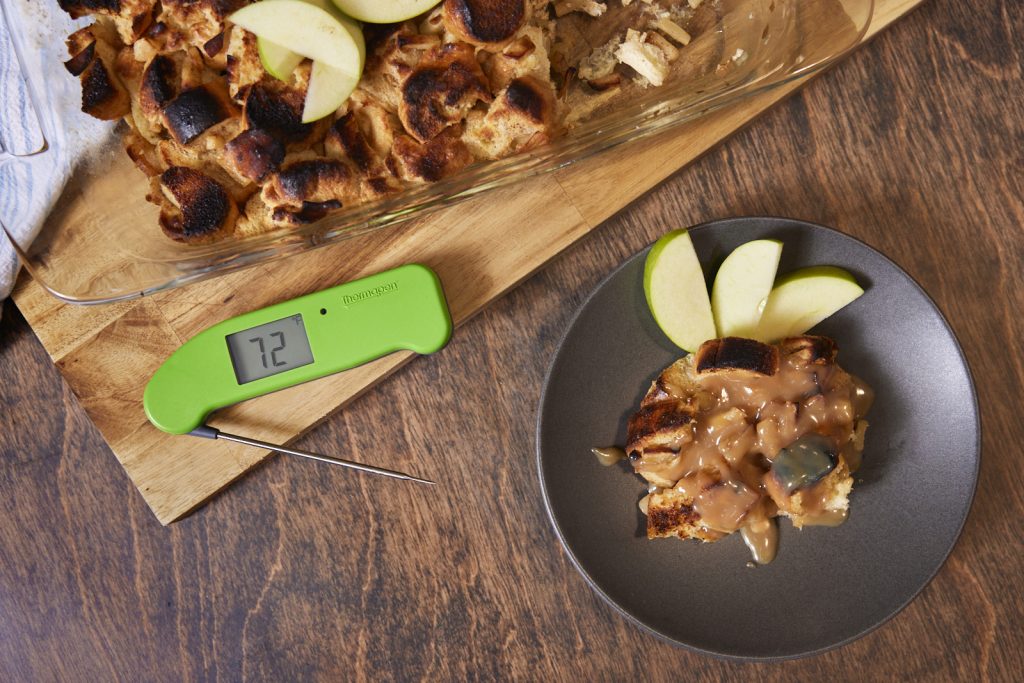
Shop for the temp-tools used in this post:
Bread pudding: custard in disguise
Bread pudding is nothing more than a custard that has been stretched with dry bread. Well, “nothing more” sounds negative, but it’s kind of true. Without the mixture of eggs and milk you pour over the cubed bread, there’s no pudding there—only croutons.2 It’s the creamy, rich, sweet custard that we’re really after in bread pudding. But it isn’t all we want—after all, we want the bread, too. This isn’t creme brulee, it’s bread pudding!
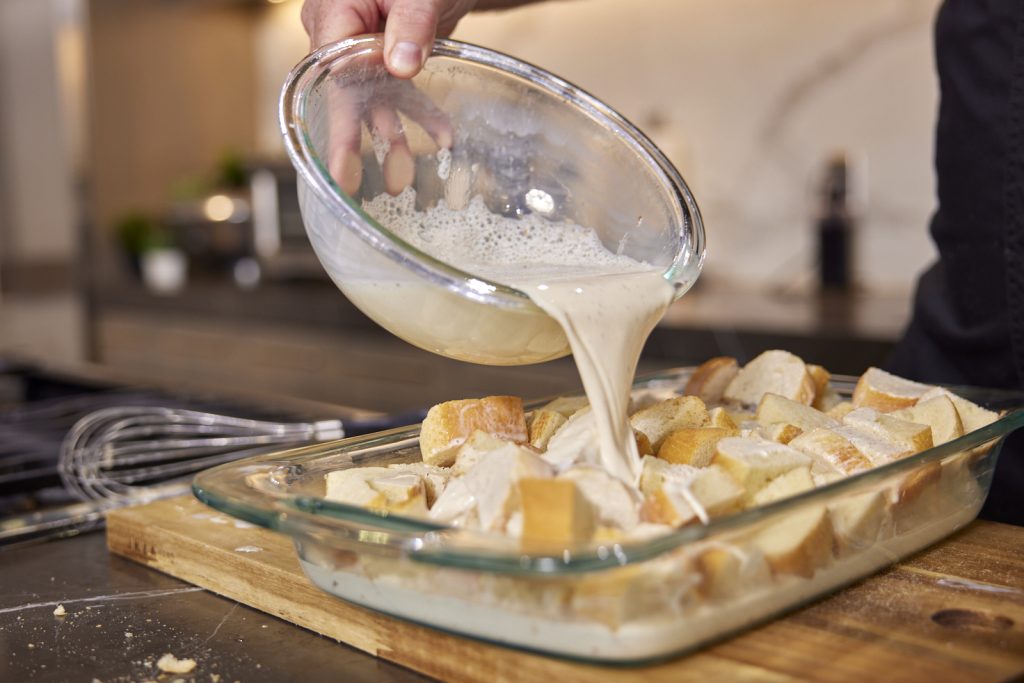
Making perfect bread pudding
Since this is a custard dish, we need to treat it as such, thermally. We want bread that is moist throughout, not chewy and dry. And what we don’t want from our custard is something that is either undercooked and runny (soggy milk bread anyone?) or overcooked and scrambled-eggy.
To accomplish all our bread-pudding goals, we need to be sure we get our ratios right, soak the bread enough, and cook it at the right temperature to the right temperature.
Bread pudding custard ratio
Bread pudding custard is best at a ratio of about 1 egg per 1 cup of liquid. Whatever the liquid is (see below for a note about that in the flavoring section), use one egg for every cup. This will give you a custard that is not too eggy. As for the bread ratio, that same cup of liquid (plus its egg) will be enough for about 4 ounces of bread. So if you’re making a giant bread pudding with 36 ounces of bread, that’s 9 cups of milk and 9 eggs. Of course, you may find you like your pudding more bready, more eggy, or more custardy. Play with the ratio to get your desired result, and then notate it somewhere permanent.
Soaking the bread pudding
To avoid dry bread, you need to let the bread soak in the custard for 10–30 minutes before baking it. You don’t have to do anything to it during that time, except turn it over once with a spatula, but it’s just a waiting game. During that time, you can properly preheat your oven. Richer bread, like brioche, needs a longer soak time, while lean bread like baguette needs less.
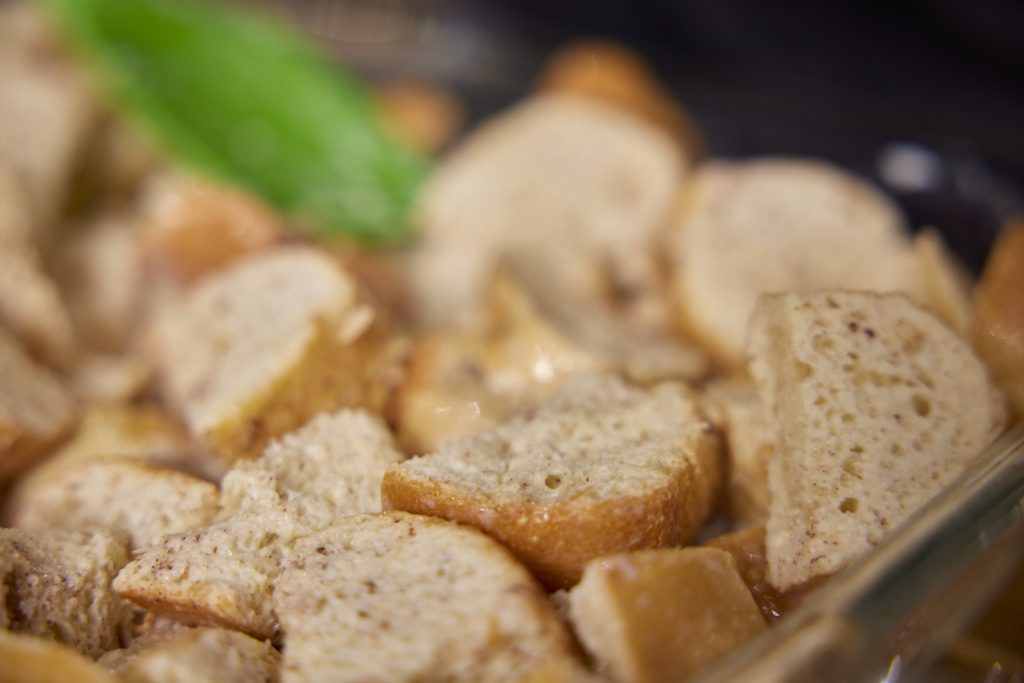
Bread pudding doneness and cooking temps
This brings us to the oven and custard temps. Have your oven preheated to 350°F (177°C)—not screaming hot, not too slow. If you think your oven might run hot or cold, you can always verify it, of course, but this is the temperature we’re looking for.
Bread pudding is done between 160 and 170°F (71 and 77°C).
Start taking its temperature with your Thermapen ONE after about half an hour, inserting it all the way through the pudding in the center and pulling it up slowly through the mass, looking for the lowest temperature.
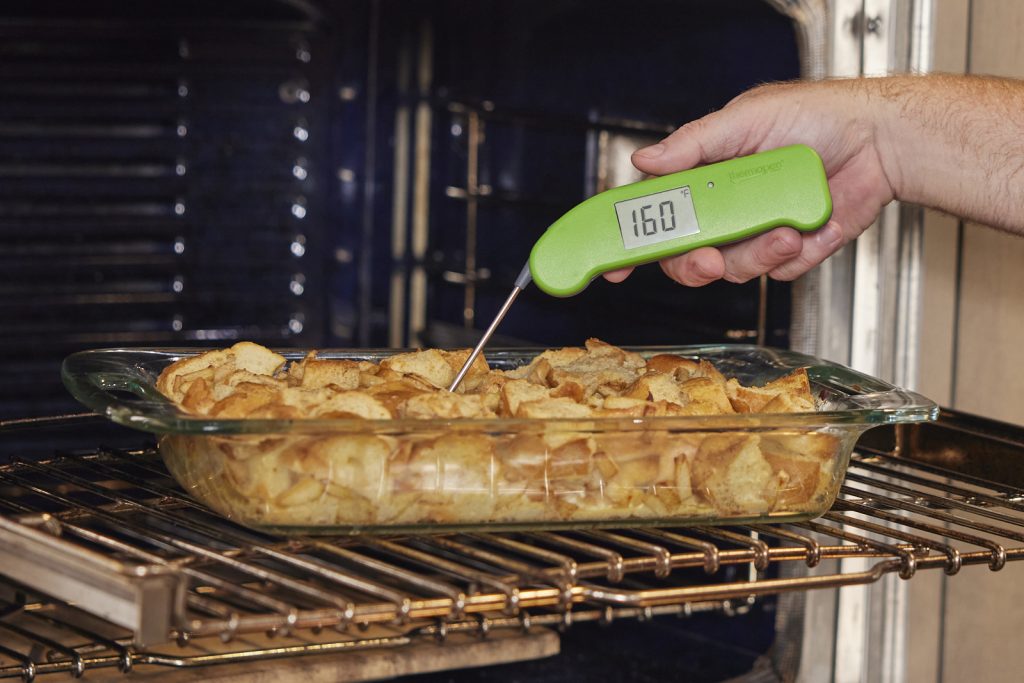
Getting to that temp took us about 35 minutes. But note that we used a 9×13″ pan (making 117in2). If you have a pan with a smaller surface area, it will take longer to cook because your pudding will be thicker.
Flavors and additions: dressing up your bread pudding
There are endless variations on bread pudding. We used some diced Granny Smith apples that were sauteed in butter with some cinnamon in ours, then topped it with a simple caramel sauce. But you can use nuts, raisins, other dried or fresh fruits, or other spices in yours. You can spike the custard with some liquor for flavor (bourbon is popular, but rum might be even better), or try milk or cream instead of half-and-half. Just keep the ratio of eggs to liquid and the ratio of custard to bread constant.
Sauces are optional, recommended, and varied. Custard sauces are great, caramel sauces are lovely, and even just some pure, warmed maple syrup is fantastic on it. Play around, have some fun!
Seasoned with warm spices and caramel, a homemade bread pudding is a kingly dessert for the winter. Sub out the warm spices and caramel for fresh berries and lightly sweetened whipped cream and it’s perfect for midsummer. There’s no wrong time to serve it! But no matter how you flavor it, the thermal principles are the same. Use your timer and Thermapen ONE to ensure perfect results every time.
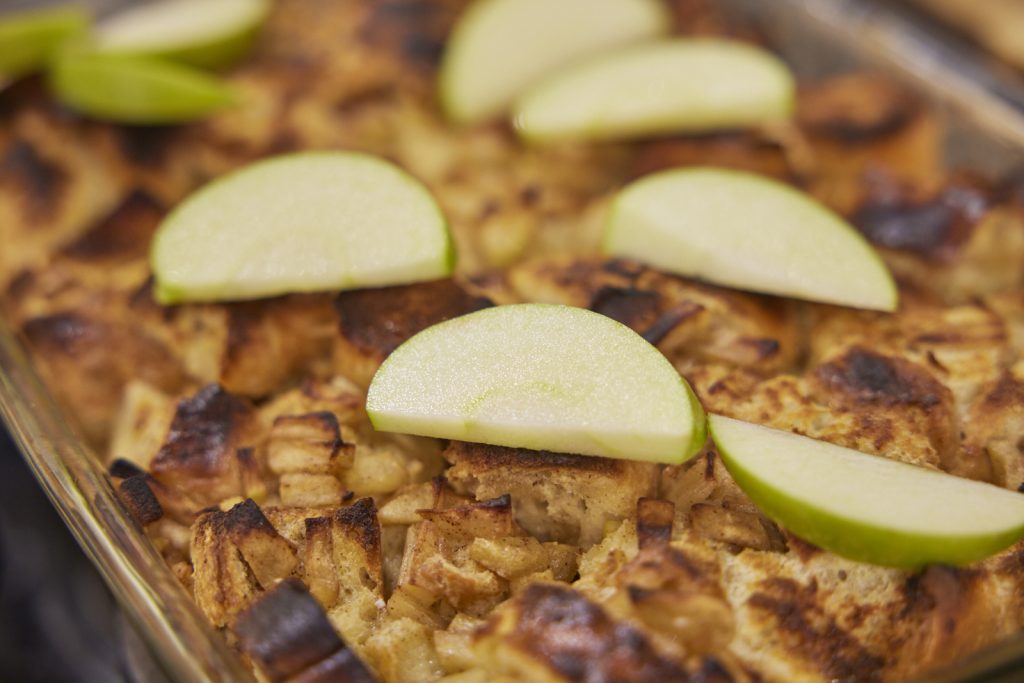

Homemade bread pudding recipe
Description
Apple cinnamon bread pudding, adapted from the base of a recipe at NatashasKitchen.com
Ingredients
- 12 oz bread, somewhat dried, cut into cubes—we used baguette, but brioche is wonderful
- 3 C half-and-half
- 3 large eggs
- 1/4 C brown sugar
- 1 tsp ground cinnamon, divided
- 1/4 tsp salt
- 1/2 tsp vanilla extract
- 2 Tbsp butter
- 2 Granny Smith apples, peeled, cored, chopped into small dice
- 1 Tbsp brandy (optional)
Instructions
- Preheat your oven to 350°F (177°C)
- Butter a 9×13″ baking dish.
- Beat the eggs in a small bowl. In a larger bowl, whisk together the half-and-half, beaten eggs, and brown sugar, 1/2 tsp cinnamon, vanilla, and salt.
- Put the bread cubes in the buttered baking dish and pour the custard mixture over the top.
- Allow the bread to soak up the custard for 10–30 minutes.
- While the bread is soaking, melt the 2 Tbsp butter in a sauté pan over medium-high heat and add the small diced apple pieces.
- Sautee the apples until they are softening and just starting to brown. Sprinkle in the rest of the cinnamon and toss to combine. If using the brandy, carefully add it to the pan and burn off the alcohol.
- Distribute the apples over the bread pudding, turning them into the mix with a spatula.
- Put the bread pudding into the oven and set a timer (perhaps an Extra Big and Loud) for 30 minutes.
- When the timer sounds, check the internal temperature of the pudding using your Thermapen ONE. If there are no temps below 160°F (71°C), remove it from the oven.
- If you want it more brown and toast, brush the surface with melted butter and place it under a medium broiler for a minute or two, but be careful not to burn the surface!
- Allow the dish to cool somewhat before serving.
- Enjoy!


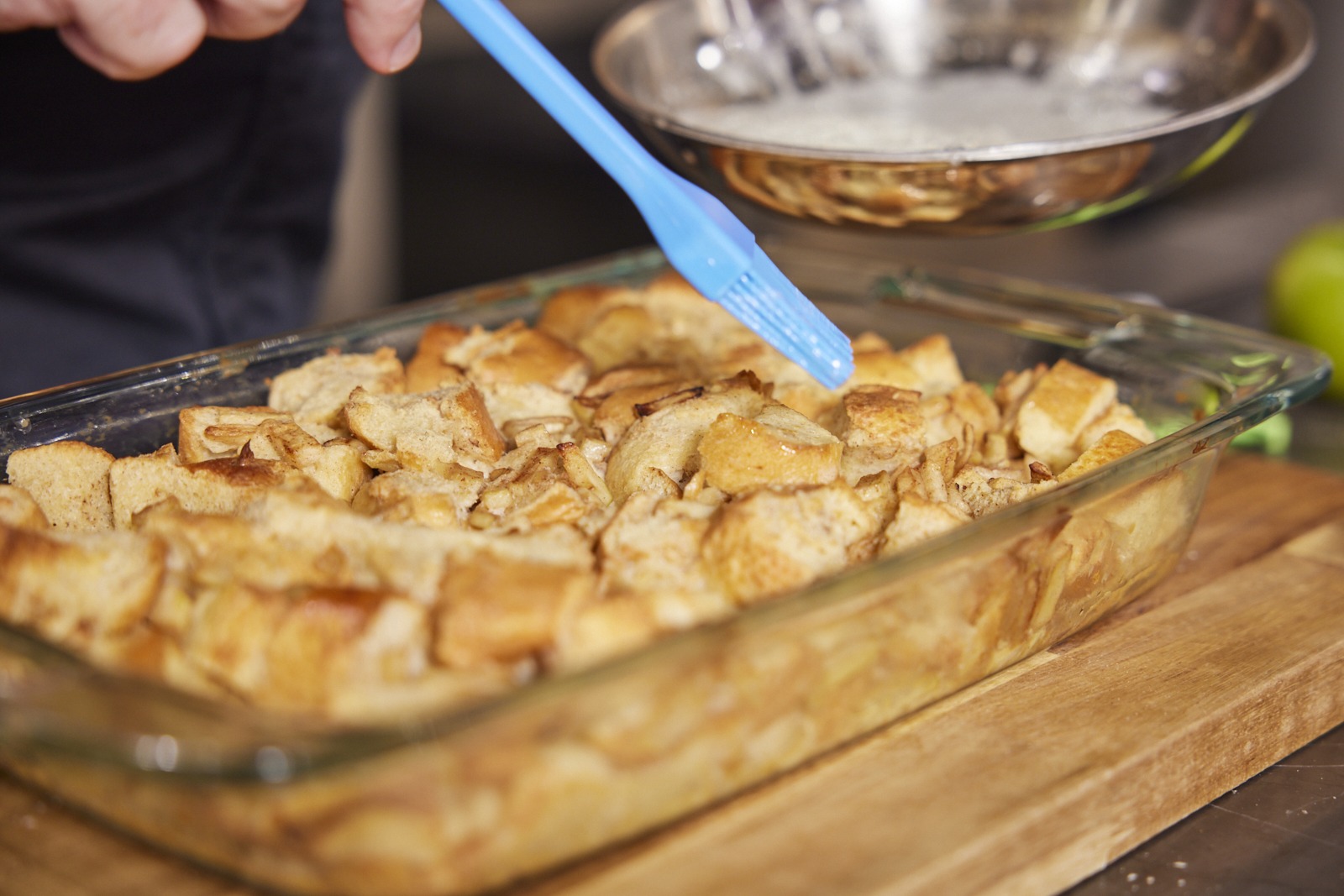
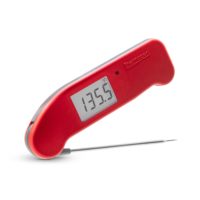
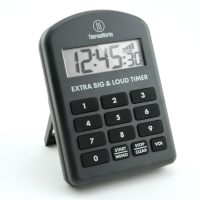
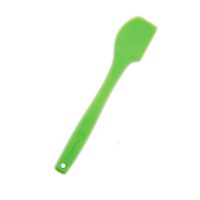
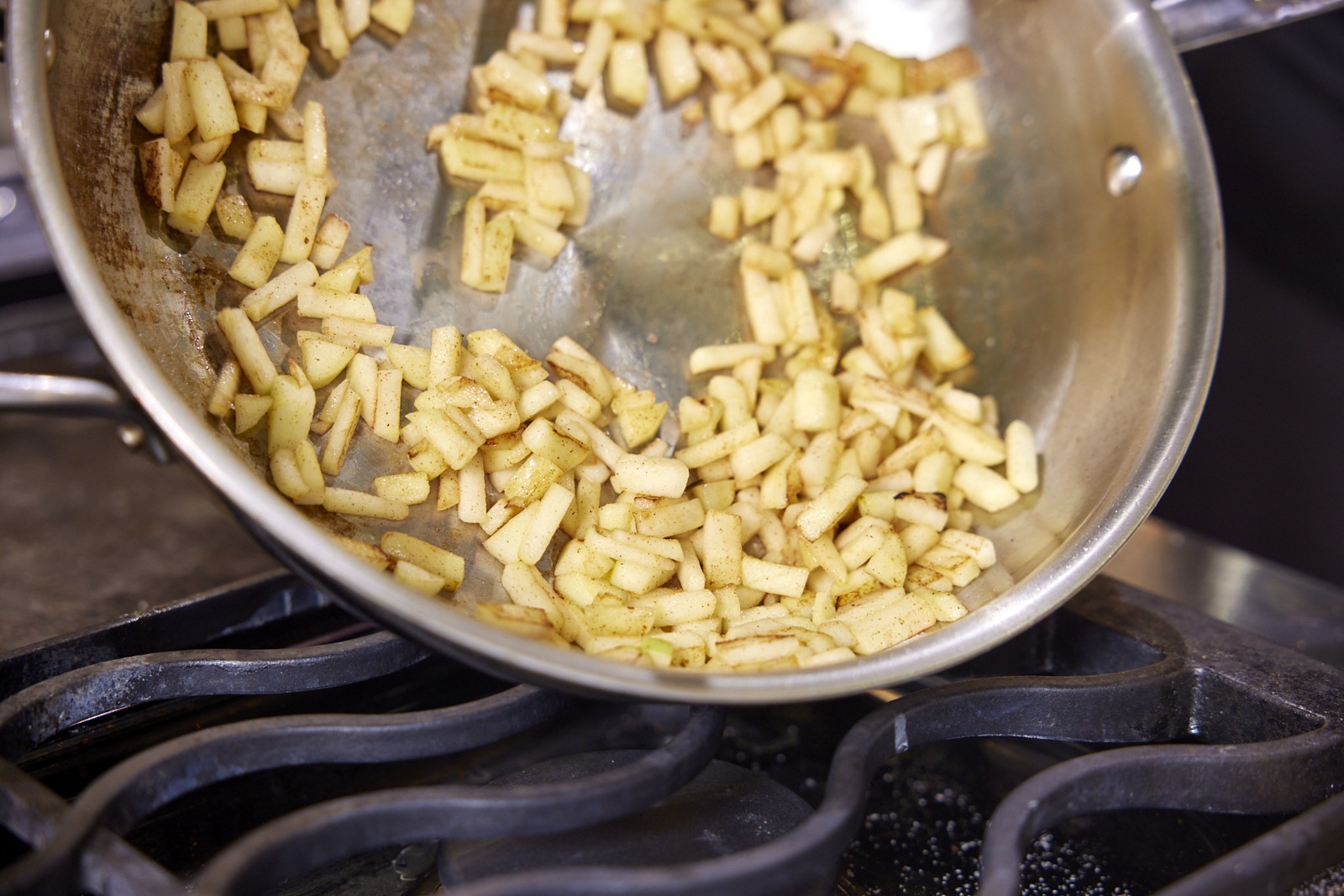
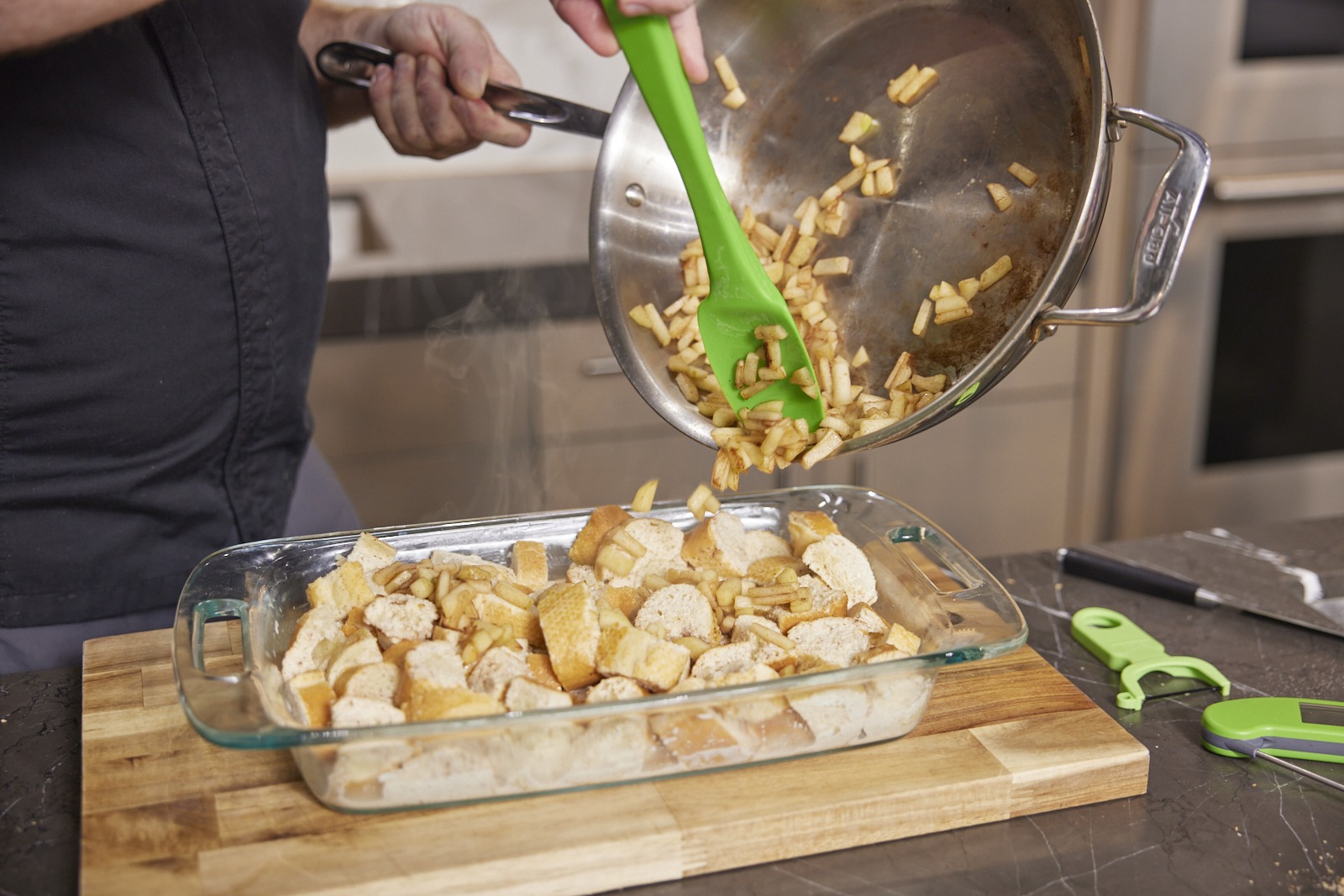
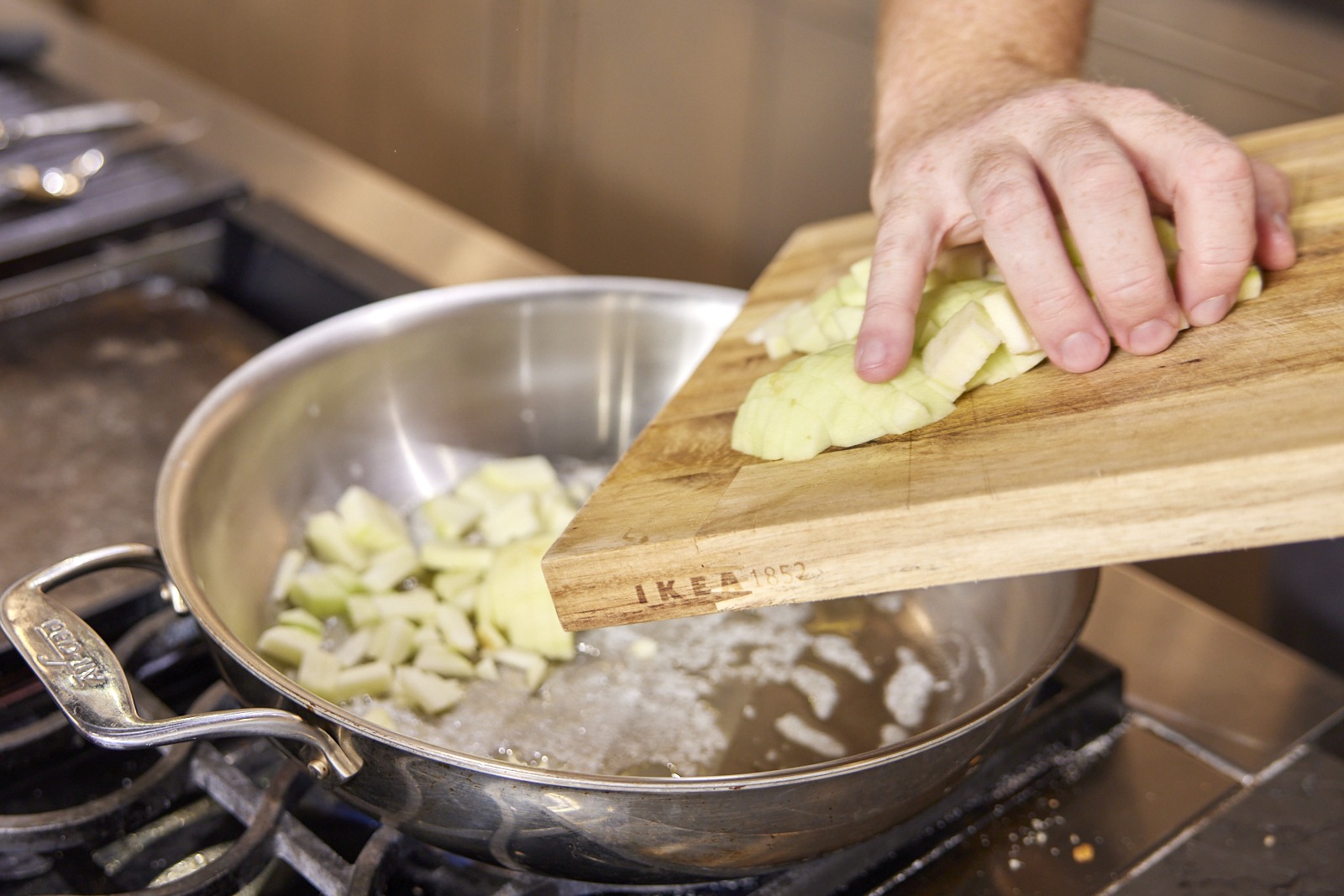
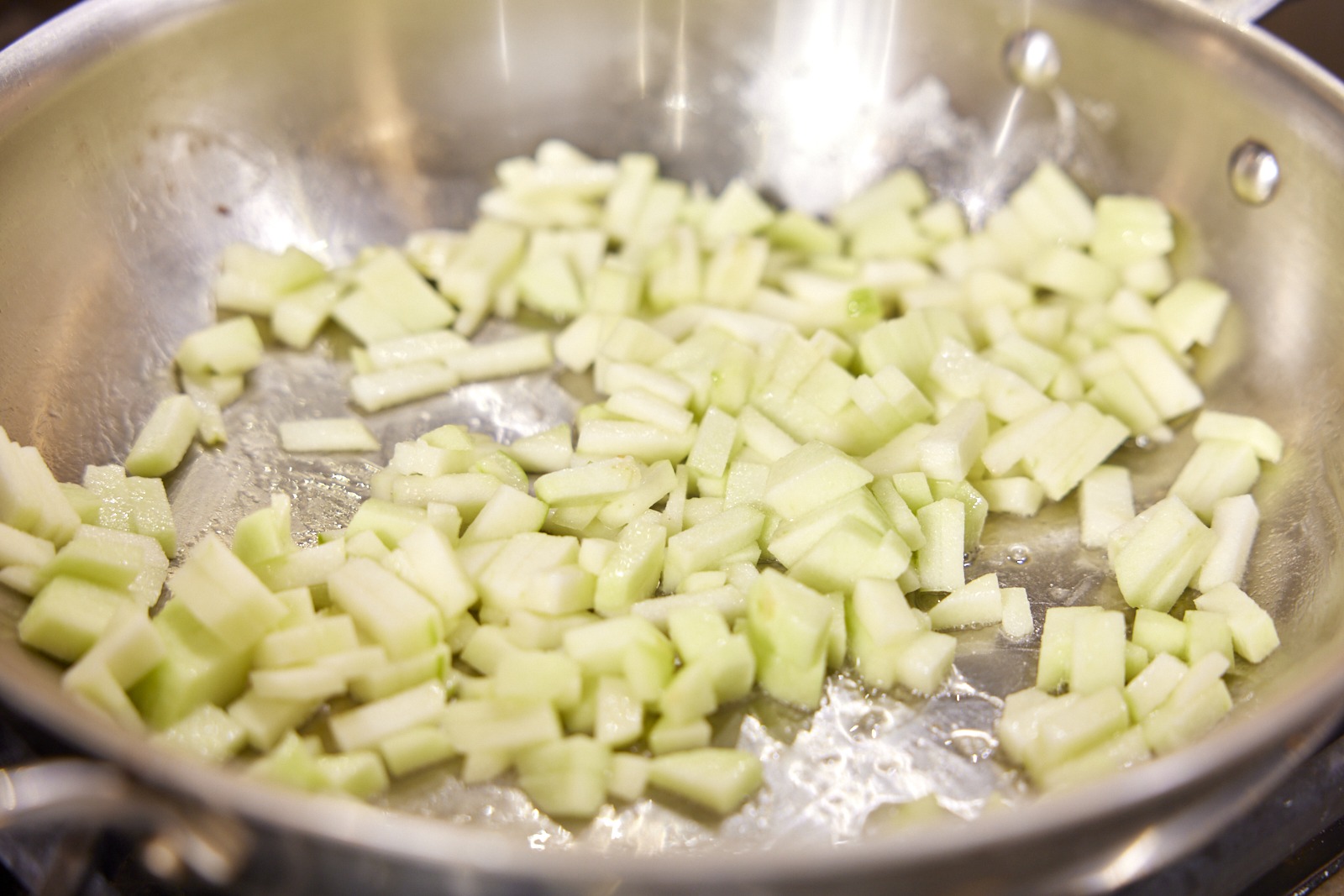
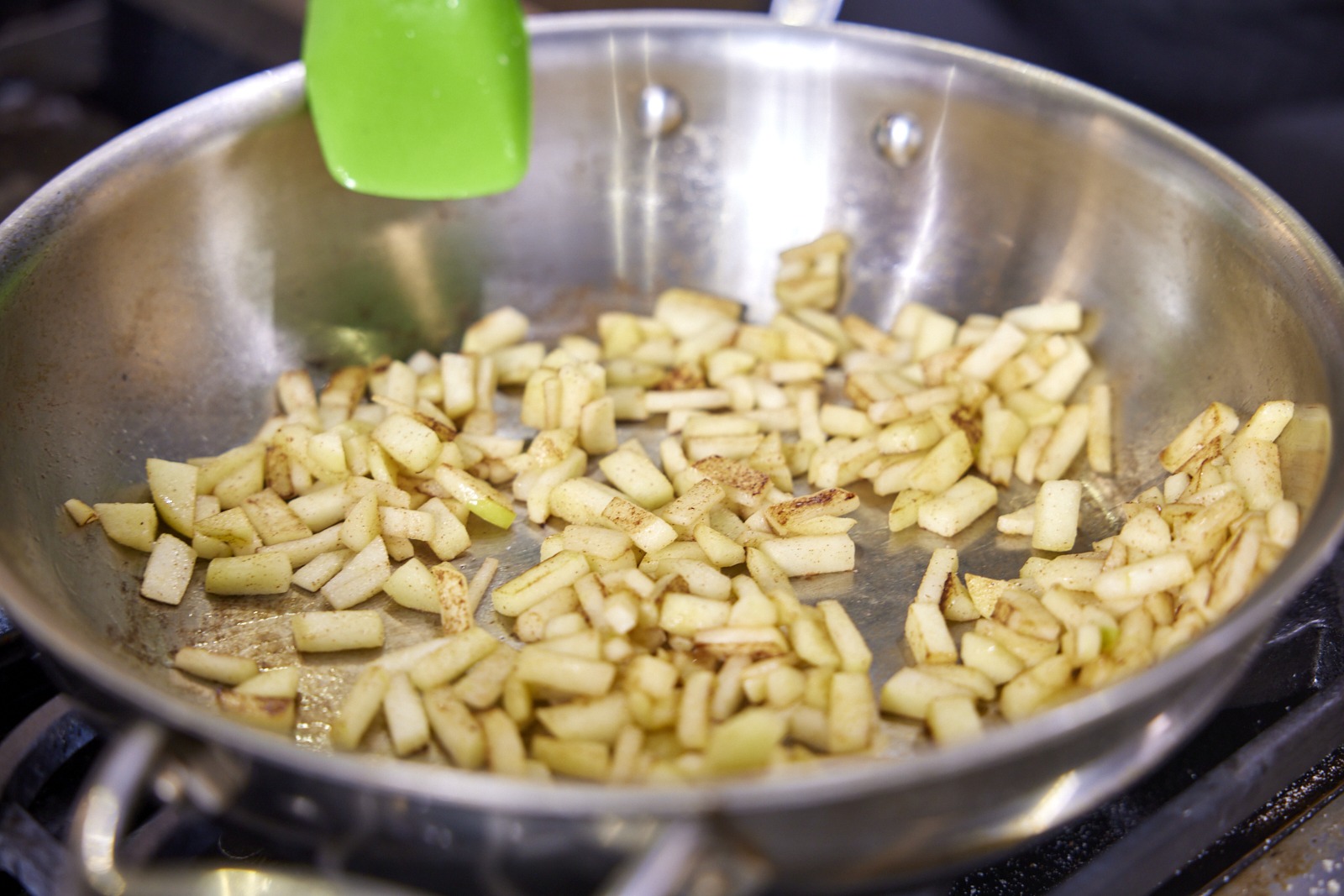
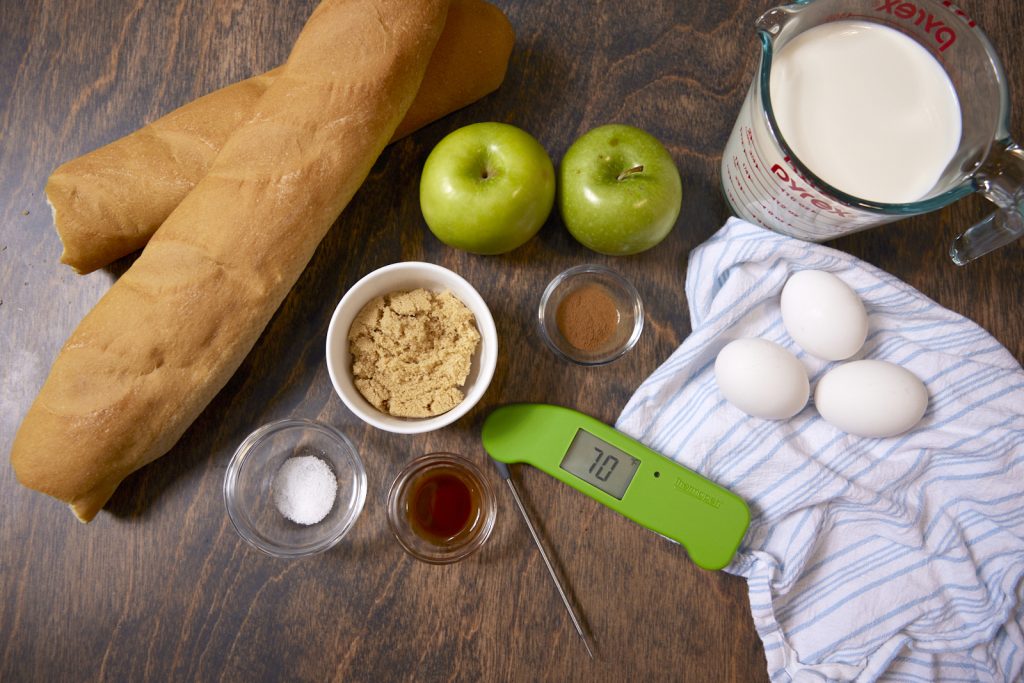
This is bread and butter pudging, real bread pudding does not contain custard.
Interesting comment. I have never had a bread pudding that didn’t have custard. I’m interested in what you define as a bread pudding that isn’t a bread and butter pudding, and welcome a recipe! According to my reading of The Oxford Companion to Food‘s article on bread puddings, even versions that do not have custard but are made with sweetened milk and raisins (“currants”) count as “bread and butter pudding”. So if even a non-custard version is a bread-and-butter pudding, what is a bread pudding that has no sweetened milk and no custard?
Still a bread pudding. I never make a custard because I am not a fan. I don’t use eggs either because of my vegetarian spouse. I add flax seed meal and chia seeds along with the almond “milk” and it turns out great.
On what planet? I lived on bread pudding and sweet potato pie growing up and I’m sorry, but you are sadly mistaken! Without custard you have croutons.
Gee Ann, Every bread pudding I ever had or made- and I’ve had it all my 70 years- has a custard base. What’s your recipe?
That’s because you are used to egg bread pudding. True French toast and bread pudding are custard in the middle. This recipe taste really good with Grand Marnire and vanilla beaten with the eggs and infused with orange oil from 2 orange’s peels (but taken out before cooking by putting through a fine mesh strainer) and a drizzle of true maple syrup on top.
This was so helpful! Knowing the ratios and the desired internal temp is exactly what I was looking for. My ThermoPen is key to my baking success (and confidence)!
Thanks Martin, I was at a loss regarding the comment about “real” bread pudding not containing a custard. She probably shouldn’t go to TN or any place down south – ever!
Even in South Africac we have custard in a bread and butter pudding. We are having guests in Saturday and I wanted to make the creamed one ever. Going to make this one. I am just scared I dry it out: but thank you for all the info on how hot it should be. Also the oven temp.
i think Ann was referring to Summer Pudding.